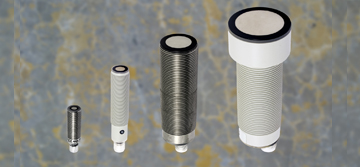
White Papers
White Papers
Proximity sensor types: inductive, capacitive and ultrasonic
Inductive sensors, capacitive sensors and ultrasonic sensors are three different proximity sensors. These devices detect targets in industrial applications. They differ for technology, capability to detect different type of targets and working distance.
All three, on the other hand, can detect object without any contact, in spite of surface color.
Inductive sensors and capacitive sensors can operate at few millimiters, whilist ultrasonic sensors can reach several meters.
What is an inductive sensor?
Inductive sensor are industrial electronic devices used to detect the presence of metal objects, without any interference of other different materials (like plastic, wood, water or oil).
Datasensing qualifies as one of the main world manufacturers of sensors, after the merger of Datalogic and M.D. Micro Detectors, two companies that have made the history of sensors in Italy since the early 1970s.
So, who better to explain this matter?
Inductive sensor working principle
Inductive sensors rely on emitting an oscillating electromagnetic field. When the metal target approaches the sensor, drain currents are generated in the target. This current drains energy from the electromagnetic field and so the amplitude of the oscillation decreases.
A threshold detector inside the sensor detects when the amplitude is below a defined value and so the output switches. When the target moves away, the drain currents in the target decrease and so the electromagnetic field amplitude increases. Over a defined threshold, the sensor output switches again in the initial working condition.
Inductive sensor: how is it made?
Inductive sensors consist basically in the following stages:
- a coil and a ferrite, that generate the electromagnetic field
- an oscillator used to drive electromagnetic field generation
- a comparator stage that compares the received signal with a switching threshold
- a transistor that drives an external actuator or directly the load.
Inductive sensor types
Inductive sensors can be distinguished by dimensions. The classification goes from cylindrical miniaturized models with 3mm diameter to M30 housing and rectangular models.
Sensing distance, installation (shielded or unshielded) and advanced functions (analogue output, weld field immune, …) are other means of classification.
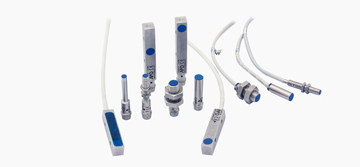
What metals does an inductive sensor sense?
As mentioned before, inductive sensors detect only metal targets. Metal targets respond in different way to the electromagnetic field according to the different type of materials.
The sensor detects different materials such as steel, stainless steel, copper, brass, or aluminum at varying maximum distances.
The standard target, according to the Standard ISO60947-5-2, is a Fe360, 1mm thickness square plate with a side accordingly to sensor dimensions and working distance. In the inductive sensor product specifications, it is possible to find the reduction factor table for different materials. Users must take care of this effect when selecting the right inductive sensors for their application.
What is a capacitive sensor?
Capacitive sensors are industrial electronic device that can detect any kind of material (metal, plastic, wood, water, …).
Capacitive sensor working principle
Capacitive sensors are based on the emission of an oscillating electric field. Capacitive sensor and target act as the plates of a capacitor.
When the target approaches the sensor, the electric field amplitude decreases until that, below a defined threshold, the trigger increases. Over a defined threshold, the sensor switches the outputs. When the target moves away from the sensor comparator makes switch again the sensor in the initial conditions.
Capacitive sensor material detection
Capacitive sensors can detect very different types of materials. The actual detection distance depends on the dielectric constant of the material itself:
- materials with high dielectric constant are detected at higher distances
- materials with low dielectric constant are detected only when they are close to the sensor
For this reason, materials such as metals and water are well detected by a capacitive sensor, while materials as flour and nylon are detected only at short distance.
Another effect that can change the effective working distance of a capacitive sensor is the humidity rate of the material. For example, it is possible to observe a different sensing detection distance between dry wood and wet wood, due to the different presence of water inside.
Further effects on the sensing distance are due to the compactness of the material itself.
The sensor is well able to detect water. Meanwhile, because ice contains air bubbles, sensors can detect it at a shorter distance. The same could happen for plastic materials: compacted panels are detected at higher distance compared to granular pellets.
Capacitive liquid level sensor
Capacitive sensors are widely used for liquid level detection. If the tank walls are made of plastic or glass, it is possible to adjust the sensitivity to detect the presence of the liquid inside.
Capacitive sensors are widely used to detect aggressive liquids or liquids that must not be contaminated getting in touch with the sensor itself. Of course, the higher the difference in terms of dielectric constant between the tank wall and the content, the better the performance
What is an ultrasonic sensor?
Ultrasonic sensors are industrial electronic devices that can detect any kind of materials (metal, plastic, wood, water, …). The detection can happen independently from color, transparency, shininess, and state (liquid, solid, and powder).
Of course, the performances depend on the sound-absorbance capability of the target surface material. The higher the absorbance, the lower the actual sensing distance. For instance, materials like spoons, powders and foams are sound absorbing.
Ultrasonic sensor working principle
Ultrasonic sensors are based on the emission of an ultrasonic beam. The beam is reflected by the target towards the sensor. The sensor measures the time delay between the emission of the ultrasonic signal and the returning echo. Since the speed of the sound in the air is well known, it is possible to infer not only if the target is present, but also the distance between sensor and target.
Since the same ultrasonic transducer is used for the emission of the signal and the detection of the echo, a particular space is present just in front of the sensor, where the detection does not happen. This area is called the ultrasonic sensor blind zone.
The blind zone is the minimum distance between the sensor head surface and the position of target with the first identifiable echo. In the blind zone, no material must be present.
In ultrasonic sensor specifications, maximum working distance and blind zone are always indicated. For obvious physical reasons, the higher the working distance the higher the blind zone.
How is an ultrasonic sensor working with different targets?
Ultrasonic sensors can detect every kind of material, but the actual working distance depends on the sound absorbing capability of the materials.
- Compact materials reflect the ultrasonic signal toward the sensors. These materials include metals, plastics or wood panels, flat liquid surfaces with no foam. In this case, the sensor detects target at the full operative distance.
- Sound absorbing materials or irregular surfaces reflect only a part of the incident signal. The former are materials like foams, textiles, plastic pellet; the latter are objects like vegetables layers, potatoes or apples. In this case, these materials absorb or spread away part of the ultrasonic beam. This means that, to increase the energy signal received from the sensor, the right choice would be a model with higher working distance and more beam energy.
Another aspect to take into account is the target's position. If the target aligns perpendicularly with the ultrasonic beam direction, it reflects all the energy towards the sensor. In contrast, if the target is tilted, part of the energy is deflected away. If the inclination increases, the sensor does not receive any energy and does not detect the target.
In case of inclined target, a possible solution is a retroreflective ultrasonic sensor. The retroreflective ultrasonic sensor requires a fixed, flat, perpendicular target to work with. The sensor is set to this reference position and every object in the middle is detected, independently from position and sound absorbing material characteristics.
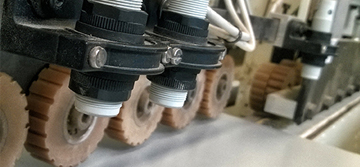
How is an ultrasonic sensor influenced by environmental factors
Ultrasonic sensors are designed in a specific environment: air with standard atmospheric pressure. So, what is happening if there is a change in:
- Transmission gas: ultrasonic sensors are designed to work in air. If there is a change in the transmission gas (nitrogen, helium, …), the speed of the ultrasonic beam changes. Given that, the distance measured at the same time can vary. The sensor may give a different reading than expected in the air.
- Temperature: the speed of the ultrasonic beam in air is dependent from the temperature. UK/UT series are fully compensated in the whole working temperature range;
- Pressure: ultrasonic sensors are designed to work in standard atmospheric pressure (1atm). Changes in environmental pressure affects the speed of the ultrasonic beam. By that, the measured distance could differ from the measure in standard conditions. The sensors are not suitable to work correctly in high or low environmental pressure;
- Dust, drops and humidity on the sensing head: ultrasonic sensors are very resistant to the presence of dirty on the sensor head. In any case if the accumulation of dirt is over a defined threshold, it influences the sensor correct working. It is necessary to keep the detection head as clean as possible;
- Air flow: ultrasonic sensors are very resistant to the presence of air flow and wind in outdoor use. In any case, it is always necessary to remind that the ultrasonic beam is moving in the air. So, if the air flow is excessive, the ultrasonic beam is deviated from the correct path to/from the target and so the detection could be unstable. For this reason, it necessary to check the position of pneumatic valves outlet;
- Environmental condition for outdoor use: ultrasonic sensor can work outdoor since they are IP67 and not affected by sunlight. In any case, harsh environmental conditions like heavy rain, snow and storm wind, can affect the correct detection of the target.
What products does Datasensing recommend?
In case you have to detect metal target at short distance, the best solution is a inductive sensor. They are not influenced by the environmental conditions (presence of water, oil, grease, nonmetal materials, …) and have a very high repeatability. See for example Datasensing series AD (M5 miniaturized), AE (M8), AM (M12), AK (M18) and AT (M30).
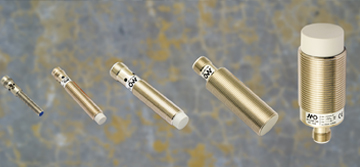
For level detection applications and detection of granular materials (like plastic pellet, seeds, …), the right choice is a capacitive sensor. By the sensitivity adjustment, it is possible to set the sensor to detect the target materials.
Datasensing recommended product lines are C18 series (M18) and C30 (M30).
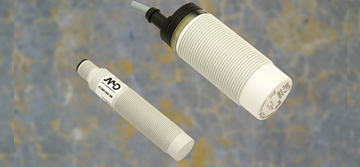
For long distance detection, ultrasonic sensors are the right solution. Ultrasonic sensors are also available with analogue output for measurement and level applications from the top of tank.
You can start your product search with Datasensing series UK (M18) and UT (M30).
